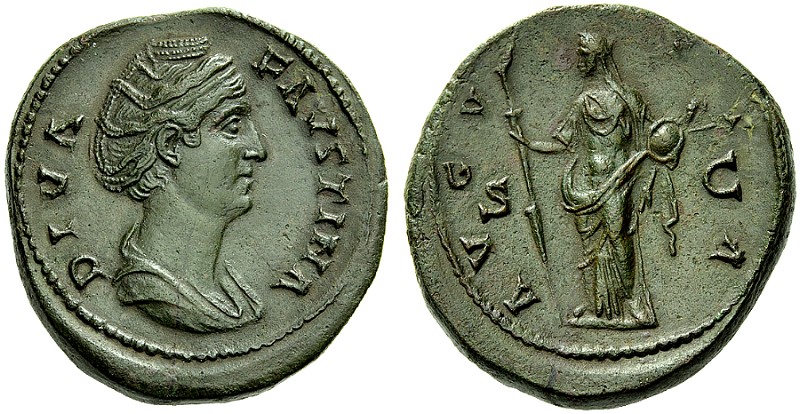S 1801 - Rome (Antoninus Pius), bronze, sestertii (Diva Faustina) (146-161 CE)
From SILVER
138 CE - 161 CE Bronze
Description
| ObverseInscription or printing placed on the obverse.: | DIVA-FAVSTINA (Latin).Draped bust of Faustina I right, hair coiled and bound on top of the head with double bands of pearls, border of dots. |
| ReverseInscription or printing placed on the reverse.: | AVGV-STA / S - C (Latin).Veiled Vesta standing left, leaning with right hand on long flaming torch and holding palladium in left hand, border of dots. |
Mint and issuing power
| MintIdentifies the place of manufacture or issue of a numismatic object.: | Rome | Ancient regionAncient region.: | Latium | Modern countryModern country: Italy | AuthorityIdentifies the issuing power. The authority can be "pretended" when the name or the portrait of X is on the coin but he/she was not the issuing power. It can also be "uncertain" when there is no mention of X on the coin but he/she was the issuing power according to the historical sources: | Antoninus Pius (Roman emperor, 138-161 AD), Roman Empire |
Chronology
| FromIdentifies the initial date in a range assigned in a numismatic context. | 138 CE | toIdentifies the final date in a range assigned in a numismatic context.. | 161 CE | PeriodTime period of the numismatic object.: Roman from 30 BC |
Physical description
| MetalThe physical material (usually metal) from which an object is made.: | Bronze |
Median weightMedian of the weights of numismatic objects (in grams). in grams | 29.00 | DenominationTerm indicating the value of a numismatic object. Examples: tetradrachm, chalkous, denarius.: | sestertius | StandardStandard.: |
Image

S1800 Rome Faustina sestertius.jpg [1]
References
| Die study referencePublication of the study: | Beckmann 20121Beckmann 2012, p. 153-168 | ||
| Coin series referenceReference to coin series study: | |||
Obverse dies distribution
| FrequencyFrequency of specimen in distribution. ᵖ | Number of obversesNumber of obverse dies. ᵖ (o) | % (o) | Number of coinsNumber of coins. (n) | % (n) | Die nameName(s) of the die(s). |
| 1 | 88 | 67.18 | 88 | 42.11 | |
| 2 | 27 | 20.61 | 54 | 25.84 | AF1, AG7, G13, E5, E7, E8, EC2, EC19, FP1, FP3, FP6, MD1, MD2, MD4, MD5, MD8, MD9, PA5, PA13, PA18, PA24, PA29, PA33, PA42, T4, T12, T14 |
| 3 | 8 | 6.11 | 24 | 11.48 | CP1, CW2, E1, E9, EC9, MD6, T7, T15 |
| 4 | 2 | 1.53 | 8 | 3.83 | E6, EC12 |
| 5 | 3 | 2.29 | 15 | 7.18 | CW1, EC5, PA21 |
| 6 | 1 | 0.76 | 6 | 2.87 | F4 |
| 7 | 2 | 1.53 | 14 | 6.7 | EC11, FP5 |
| Total | 131 of 131 | 100.01 | 209 of 209 | 100.01 |
Reverse dies distribution
no distribution is available
Quantification
| Number of obversesNumber of obverse dies. ᵖ (o) | 131 | Number of singletons (o1)The number of singleton coins. ᵖ | 88 |
| Number of reverse diesNumber of reverse dies. (r) | Number of coinsNumber of coins. (n) | 209 | |
| Coins per obverse dieNumber of coins per obverse die. (n/o) | 1.6 | Coins per reverse dieNumber of coins per reverse die. (n/r) | |
| Reverse per obverse ratioRatio of obverse dies divided by reverse dies. (r/o) | Percentage of singletons (o1)number of coins (n) divided by the number of singletons (o1) ᵖ | 67.18 % | |
| Original number of dies (O) (Carter 1983 formula)The estimation of the number of coins according to Carter 1983 ᵖ | 282.49 | Coins struck if 20,000 as average productivity per dieCoins made if the average productivity for obverses (according to Carter) is 20,000. ᵖ | 5,649,800 |
| Original number of dies (O) (Esty 2011 formula)The estimation of the number of coins according to the singleton formula in Esty 2011 ᵖ (O) | 351.01 | Survival rate if 20,000 as average productivity per dieSurvival rate if average productivity is 20,000. ᵖ | 0.00004 |
| Coverage (o = % of O) (Esty 1984 formula)Esty 1984 - coverage (% of O) ᵖ (o = % of O) | 57.89% | Die productivity if survival rate 1/2,000Average productivity if survival rate is 1/2,000. ᵖ | 1,479.7 |
| Weight of silver (in kg) if 20,000 coins per die (O = Carter formula)Carter 1983 * Median weight * 20000 (*10 if gold or electrum) ᵖ | n.a. | Die productivity if survival rate 1/5,000Average productivity if survival rate is 1/5,000. ᵖ | 3,699.25 |
Remarks
References
- ^ Beckmann, Martin (2012), Diva Faustina. Coinage and Cult in Rome and the Provinces, Numismatic Studies 26, New York, 170 p., 17 pl.